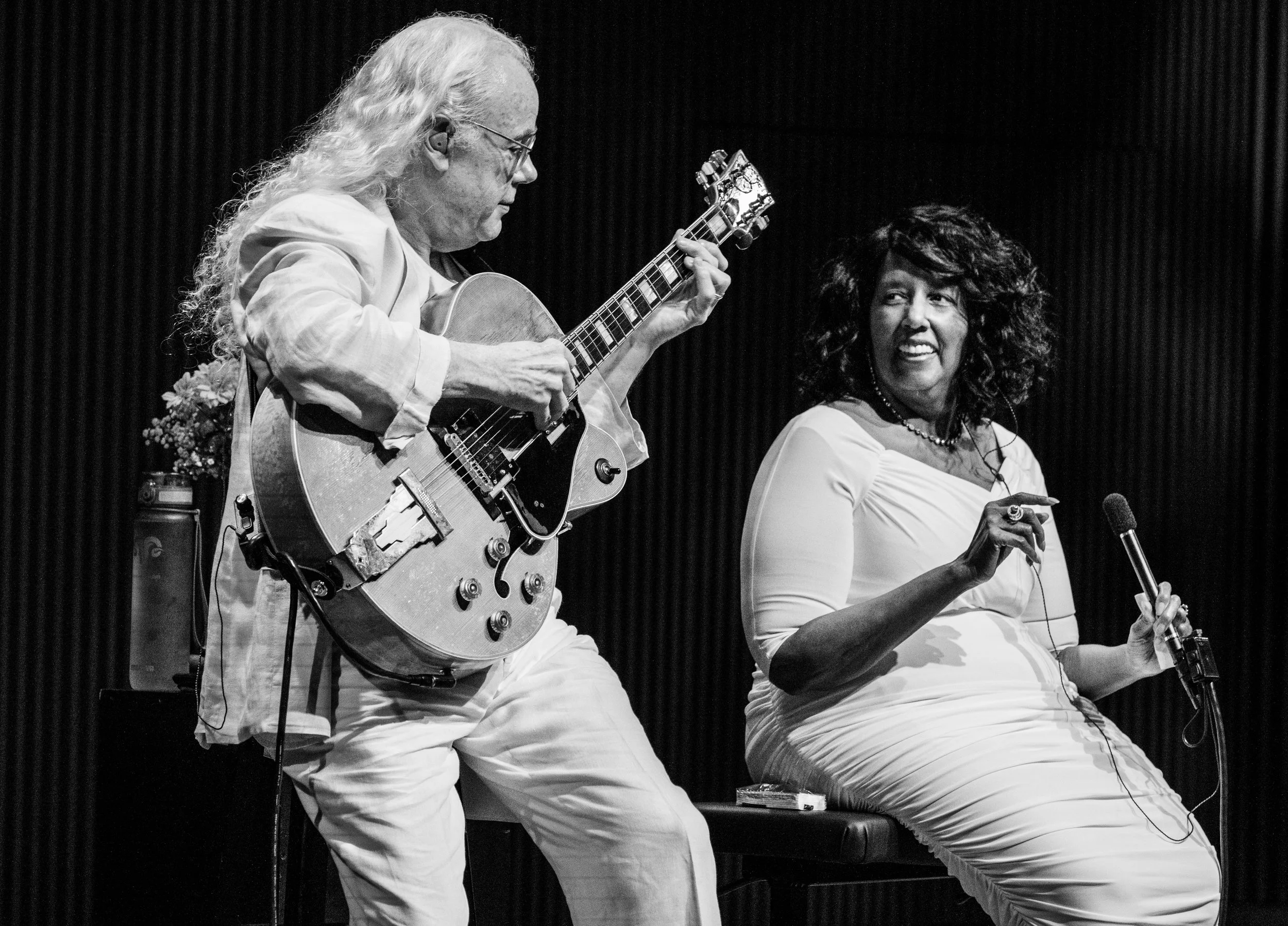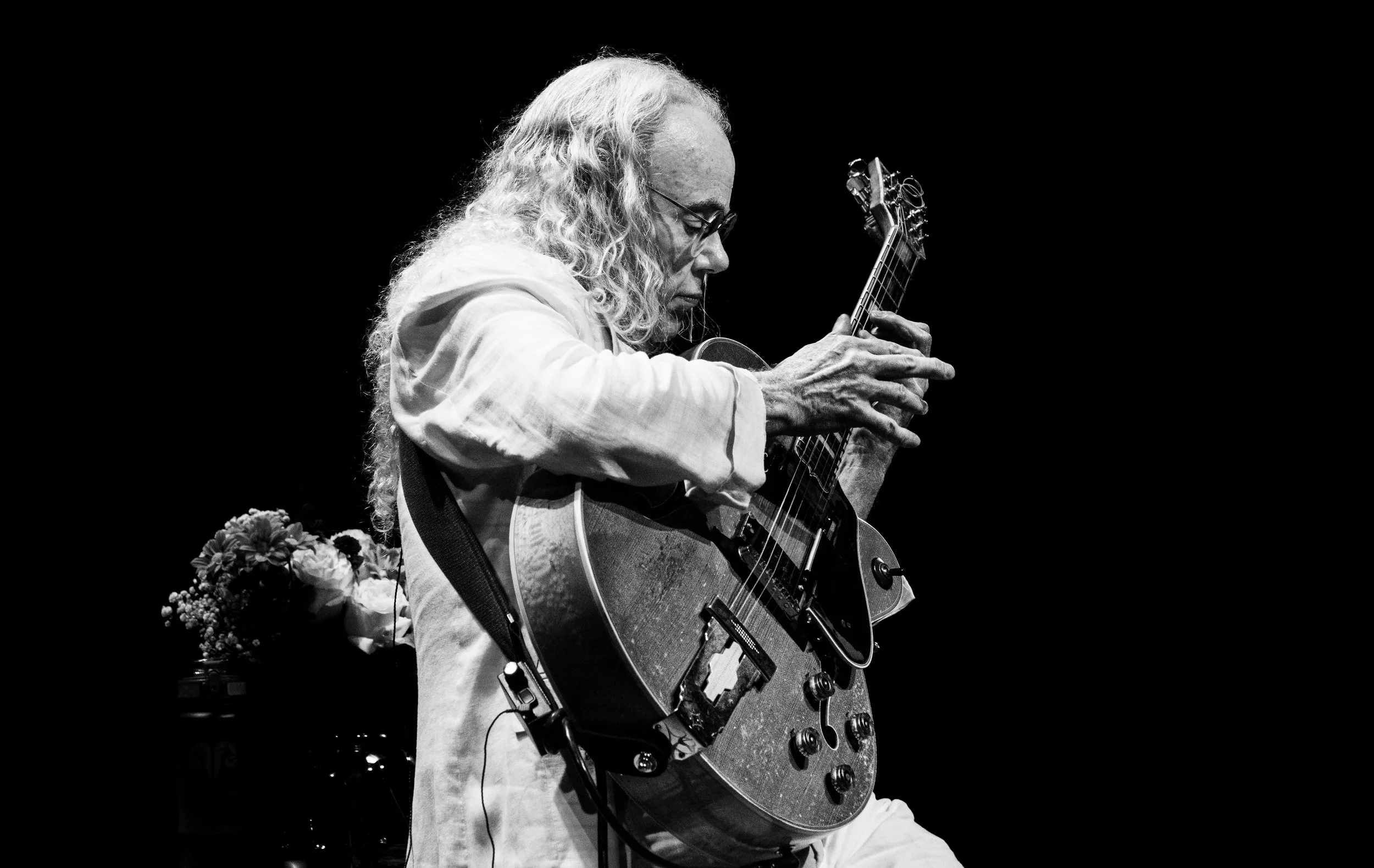Two Chairs, One Language: The Loving Art of Tuck & Patti
Tuck & Patti. Photo: Steve Roby
You could feel the room hold its breath as Patti Cathcart settled onto a piano bench, cane set aside, Tuck Andress and guitar at her shoulder. The first song, “Mystical Miracle,” was offered to the women in the house, and landed like a mission statement: honest affection, transparent vulnerability. Seen up close, the duo’s vaunted intimacy is not a stylistic pose; it is the operating system. And when the operating system is love, time behaves differently.
Throughout the evening, the main theme was resilience that avoids spectacle. We learned—briefly and without melodrama—why Patti moved slowly: a concussion from a fall in Milan, lingering vertigo, and a cold. Then came the moment that always seems to happen at a Tuck & Patti show: the confession turns into craft. The story leads to a song as she weaves a witty, bluesy aside about ditching the high heels and holding onto faith. The crowd recognized the magic that has defined this partnership since the late ’70s: personal details turned into shared emotion.
Technically inclined listeners—especially guitar players—had a feast. Tuck’s 1953 Gibson L‑5, customized with a Bartolini pickup and buffer preamp, went directly to the house PA: no amp, no effects maze, just a disciplined signal path and a player who has learned to be a one-man section without sounding like a gimmick. His “sustain without the crutch” approach leaves space for percussive taps, artificial harmonics, and short, singing lines that can be woven into chordal textures on demand—an orchestration vocabulary, not a bag of tricks. The result is a kind of fingerstyle counterpoint that never overcrowds the singer and keeps harmonic possibilities actively in play.
Tuck Andress. Photo: Steve Roby
Tuck name-checked Bobby McFerrin as a decisive influence, serving as the origin story for his “one‑note first, then another” discipline. The anecdote mattered because it unlocked the meaning of the evening’s solo episodes: his interpretation of “‘Round Midnight” started as a single-line meditation and gradually added fuller voicings, like a painter sketching the silhouette before filling in the tones. The lesson—melody as authority, harmony as consequence—was clear, audible, and visible.
The set design—song choices, pacing, patter—favored communion over display. Audience requests were invited twice, and when the time came for “Time After Time,” Patti, the conductor, emerged, carving a three‑part chorus from the floor as if to prove that this music is participatory, not decorative. The sensation lingered through the closing hush before the ovation for “Takes My Breath Away.”
Of course, the evening was also a celebration of calendar milestones: a 44th wedding anniversary two days earlier, Patti’s 76th birthday the day before. These facts matter not for sentiment but for context. Since Tears of Joy (1988), the duo has developed a portable, resilient model of modern song performance: small forces, big communication; repertoire that spans standards, pop ballads, and originals without apology; the confidence that “it just sounds like Tuck & Patti.” If you want an indicator of artistic identity, consider that all those crossings never seem like fusion experiments. They feel like two musicians preserving a language of care.
They constantly adjust to each other: Patti shapes a word; Tuck changes his chords or timing to fit. The small fixes make everything sound smooth. The “no‑fault zone,” Patti declared from the stage, is not a permission slip for sloppiness; it is a professional ethic that honors the risks inherent in live music. Mistakes are absorbed, not erased, and the song keeps telling the truth.
Tuck & Patti. Photo: Steve Roby
Highlights? A compact but probing “‘Round Midnight” that treats the tune like a sculpture—walked around slowly, lit from different sides; “Europa,” rendered not as a stadium hymn but as a lyrical soliloquy; and a Hendrix diptych (“Castles Made of Sand/Little Wing”) that refused guitar‑hero cosplay in favor of contour and breath. On the vocal side, “My Romance” arrived with the gravity of a first‑principles creed—they have been carrying it since the day they met—and “Better Than Anything” smiled without winking. These were not new tricks or surprise arrangements; they were acts of stewardship, proof that durable songs can be renewed by care.
If you came for pure horsepower, you still got it. Even fighting off a cold and steering through vertigo, Patti’s instrument remained remarkably centered: pitch accurate, vibrato deliberate, consonants clear. The impressive part was not endurance for its own sake; it was judgment. She managed her volume, relied on her breath, and let the narrative be the amplifier. When the register rose, Tuck responded not with volume but with clarity—drier voicings, cleaner attacks—so her upper mids could flourish without glare. The duo’s much-praised “blend” is really a series of dozens of micro-decisions per minute, all serving the lyric.
The evening’s stories—funny, painful, mundane—connected the music to the life that gives it meaning. Patti’s story of an accident at the Blue Note Milan, with its dark humor of, “If I die… get a dog,” was not self-pity but perspective: recognizing that the line between stage and emergency can be just bad stairs, and that music’s purpose is to turn chance into significance. From there, the request moment returned to the community, and the final tableau—hand‑in‑hand, steady exit, no cane—felt like a statement about what partnership can achieve.
Longtime observers sometimes describe the duo’s career as a case for minimalism. That misses the point. The Tuck & Patti approach isn’t about smallness but sufficiency: how much musical information is truly needed to express the emotional truth of a song. The guitar can be like an orchestra, yes, but only because the voice is regarded as a sovereign melodic line whose meaning is clarified, not decorated, by harmony. That hierarchy—melody first, then color—makes their pop choices feel inevitable instead of ironic, and their standards feel freshly earned.
The key takeaway is simple and powerful. This duo’s music shows that tenderness is disciplined, practiced, and ever-renewing. That night, the discipline was evident in careful pacing, smart gear choices, and arrangements that felt alive; the practice showed in honest dialogue and an open invitation to sing; the renewal appeared in a singer who refused to let illness or dizziness define the evening and a guitarist who continued building spaces for her to move through. If you're judging what lasts in jazz and songwriting, here's a clear prediction: as long as T and P keep showing up with this much attention, their songs will continue to remind everyone how to listen to each other—time after time.
Setlist: "Mystical Miracle," "Love Is The Key," "One For All," "High Heel Blues," "Love Warriors," "My Romance," "Better Than Anything," "‘Round Midnight (Thelonious Monk cover) (Tuck Solo)," "Europa (Earth’s Cry, Heaven’s Smile), (Tuck solo)" "Castles Made of Sand/Little Wing," "Happy Birthday," "Time After Time," "Takes My Breath Away."


